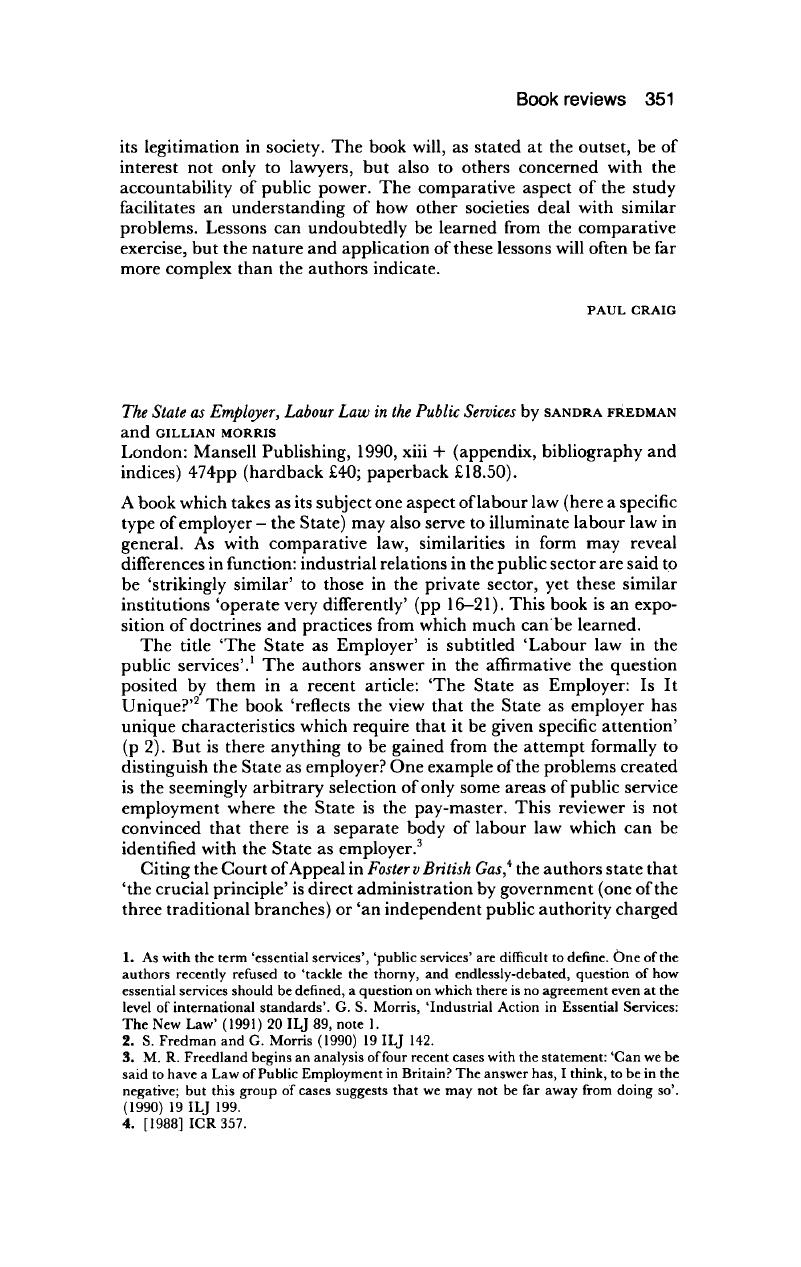No CrossRef data available.
Published online by Cambridge University Press: 02 January 2018

1. As with the term ‘essential services’, ‘public services’ are difficult to define. One of the authors recently refused to ‘tackle the thorny, and endlessly-debated, question of how essential services should be defined, a question on which there is no agreement even at the level of international standards’. G. S. Morris, ‘Industrial Action in Essential Services: The New Law’ (1991) 20 ILJ 89, note 1.
2. Fredman, S. and Morris, G. (1990) 19 ILJ 142 CrossRefGoogle Scholar.
3. M. R. Freedland begins an analysis offour recent cases with the statement: ‘Can we be said to have a Law of Public Employment in Britain? The answer has, I think, to be in the negative; but this group of cases suggests that we may not be far away from doing so’. (1990) 19 ILJ 199.
4. [1988] ICR 357.
5. [1990] IRLR 353.
6. See the decision of a Scottish industrial tribunal in Turpie v University of Glasgow, discussed in D. Curtain, ‘The Province of Government: Delimiting the Direct Effect of Directives in the Common Law Context’ [1990] EurLR 195 at 204-205.
7. (1987) 16 ILJ 423.
8. Ibid, p 425.
9. See Powell v London Borough ofBrent [1987] IRLR 466, CA, cited on pp 57-58.
10. See the last sentence of this review.
11. See generally, G. S. Morris, Strikes in Essential Services, 1986.
12. R. L. Hale, (1935) 35 Columbia Law Review 149, quoted in B. Bercusson, ‘Economic policy: State and private ordering’, in Daintith, T. C. (ed), Law as an Instrument of Economzc Policy: Comparative and Critical Approaches, 1988, p 359 at p 361Google Scholar.
13. Bercusson, ibid.
14. Compare Cain, M., ‘Introduction: Towards an Understanding of the International State’ (1983) 11 IntJSocL 1 Google Scholar.
15. Marshall v Southampton and South West Hampshire Area Health Authority [1986] IRLR 140, [1986] ECR 723. The page number in the IRLR is cited correctly in footnote 276 on page 380, but not in footnote 287 on the same page.
16. Rolls Royce plc v Doughty [1987] IRLR 447.
17. Foster v British Gas plc [1988] IRLR 354. At the time of writing the book, only the judgment of the Court of Appeal was available to the authors.
18. Johnston u Royal Uhter Constabulary [1986] IRLR 263.
19. Case 103/88, [1989] ECR 1839.
20. Case No 188/89, [1990] IRLR 353. The significance of this judgment for labour law in general is highlighted by the impending wave of Directives in European Community social and labour law following the Community Charter of Fundamental Social Rights of Workers. See Bercusson, B., ‘The European Community's Charter of Fundamental Social Rights of Workers’ (1990) 53 MLR 624 CrossRefGoogle Scholar.
21. Cf the consequences of the effet utile doctrine, which could have eliminated the requirement of control by changing the context from State responsibility to effectiveness of EC law. See Easson, A., ‘Can directives impose obligations on individuals?’ (1979) 4 EurLR 67 Google Scholar.
22. Supra, note 6, p 201.
23. B. Bercusson, Fair Wages Resolutions, 1978.
24. See the arguments in M. R. Freedland's analysis ofthe Youth Training Scheme (1983) 12 ILJ 220.
25. On the finance criterion, the universities should be considered as State employment. See the argument by Curtain op cit, on pp 204-205.
26. Curtain, op cit, pp 220-223; Docksey, C. and Fitzpatrick, B., ‘The Duty of National Courts to Interpret Provisions of National Law in Accordance with Community Law’ (1991) 20 ILJ 113 CrossRefGoogle Scholar.
27. Hepple, B. A. and Byre, A., ‘EEC Labour Law in the United Kingdom - A New Approach’ (1989) 18 ILJ 129 at 131CrossRefGoogle Scholar.
28. 1974, pp 188-190.
29. Cf Hepple, B. A., ‘Re-structuring Employment Rights’ (1986) 15 ILJ 69 CrossRefGoogle Scholar. On the many legal relationships of employees of which that with the employer is only one see R Benedictus and B Bercusson Labour Law: Cases and Materials, 1987, pp 9-25.
30. For comparative data, E. Kirchner, Public Service Unions in the Europcan Community, 1983.
31. R. H. Fryer, A. J. Fairclough and T. B. Manson (1978) 16 British Journal of Industrial Relations 160.
32. Though Michael Rubenstein argues to the contrary that, as regards procedural fairness, there has been a reversal in the trend against the employee in public law as compared to labour law. Commentary in [1990] IRLR (August) p 313; and see ‘Public law and private law rights in employment’, IRLIB No 406, 1 August 1990, pp 2-9.
33. S. Fredman and S. Lee: ‘Natural Justice for Employees: The Unacceptable Faith of Proceduralism’ [1986] 15 ILJ 15, cited in note 73 on p 264.
34. Benedictus and Bercusson, op cit, p 351.
35. The treatment of the law on unfair dismissal is very brief (pp 286-296). The text does draw extensively on case law concerning public services, but there is virtually nothing on reasons for dismissal, though an argument could be made that a ‘model’ employer has substantively different standards and procedures of fairness regarding cases of illness, incompetence, misconduct and so on. See the conjunction of principles of public law and labour law exemplified by the Court of Appeal's decision in R v Hertfordshire County Council, ex p National Union of public Employees [1985] IRLR 258, and the comment in Benedictus and Bercusson, op cit, pp 72-73.
36. For a discussion of the general problem, see Benedictus and Bercusson, op cit, ‘Introduction’, pp 1-5.
37. G. S. Morris, op cit.
38. Fredman and Lee, op cit.
39. Fredman, S. and Morris, G., ‘Public or private? State employees and judicial review’ (1991) 107 LQR 298 Google Scholar.
40. Morris, G., Fredman, S. and Hayes, J., ‘Free movement and the public sector’ (1990) 19 ILJ 20 CrossRefGoogle Scholar.
41. Supra, note 39, p 316, note 91.